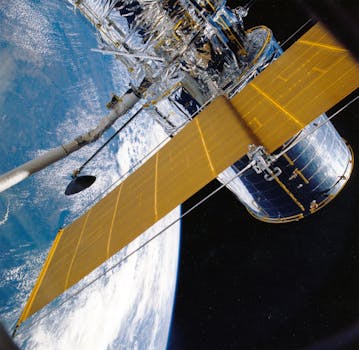
GEO Satellites: Introduction to Geostationary Orbit Satellites
GEO satellites, or geostationary orbit satellites, are a type of satellite that orbits the Earth at an altitude of approximately 36,000 kilometers, which is the same distance as the Earth’s equatorial radius. This allows them to remain stationary in the sky, relative to a fixed point on the Earth’s surface. The focus keyword GEO satellites is used to describe this type of satellite technology. GEO satellites are used for a variety of purposes, including telecommunications, weather forecasting, and earth observation.
The concept of GEO satellites was first proposed by science fiction writer Arthur C. Clarke in 1945, and the first GEO satellite was launched in 1963. Since then, hundreds of GEO satellites have been launched, and they have become a crucial part of modern telecommunications and earth observation systems. GEO satellites are used by telecommunications companies to provide services such as television broadcasting, internet connectivity, and mobile phone networks. They are also used by governments and private companies for earth observation, weather forecasting, and disaster monitoring.
How GEO Satellites Work
GEO satellites work by using a combination of propulsion systems and gravitational forces to maintain their orbit around the Earth. They are typically launched into a geostationary transfer orbit, which is an elliptical orbit that takes the satellite from the Earth’s surface to the geostationary orbit. Once in the geostationary orbit, the satellite uses its propulsion system to maintain its position and velocity, and to make any necessary adjustments to its orbit.
GEO satellites use a variety of instruments and sensors to collect data and perform their intended functions. For example, telecommunications satellites use transponders to receive and transmit signals, while earth observation satellites use cameras and other sensors to collect data about the Earth’s surface and atmosphere. The data collected by GEO satellites is then transmitted back to Earth, where it is processed and used for a variety of purposes.
Applications of GEO Satellites
GEO satellites have a wide range of applications, including telecommunications, weather forecasting, and earth observation. They are used by telecommunications companies to provide services such as television broadcasting, internet connectivity, and mobile phone networks. They are also used by governments and private companies for earth observation, weather forecasting, and disaster monitoring.
One of the most significant applications of GEO satellites is in the field of telecommunications. GEO satellites are used to provide internet connectivity to remote and underserved areas, where traditional telecommunications infrastructure is not available. They are also used to provide television broadcasting services, including direct-to-home television and satellite radio.
GEO satellites are also used for earth observation, which involves collecting data about the Earth’s surface and atmosphere using cameras and other sensors. This data is used for a variety of purposes, including weather forecasting, disaster monitoring, and environmental monitoring. For example, GEO satellites can be used to track hurricanes and other severe weather events, and to monitor the spread of wildfires and other natural disasters.
Future of GEO Satellites
The future of GEO satellites is likely to be shaped by advances in technology and changes in the global telecommunications and earth observation markets. One of the most significant trends in the GEO satellite industry is the development of new technologies, such as high-throughput satellites and satellite constellations. High-throughput satellites are designed to provide faster and more reliable internet connectivity, while satellite constellations involve the use of multiple satellites to provide global coverage and redundancy.
Another trend in the GEO satellite industry is the increasing use of commercial GEO satellites for earth observation and other applications. This includes the use of commercial GEO satellites for environmental monitoring, disaster response, and other purposes. The use of commercial GEO satellites is likely to continue to grow in the future, as the cost of launching and operating satellites decreases and the demand for satellite-based services increases.